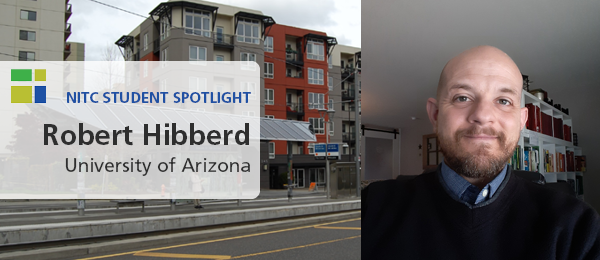Student Spotlight: Robert Hibberd, University of Arizona

Robert Hibberd is a Ph.D. student and Graduate Research Assistant in the University of Arizona's College of Architecture, Planning & Landscape Architecture. His research emphasis is on urban and transportation planning, demographics, Smart Growth and New Urbanism, housing affordability issues, and sustainable development. He has worked on multiple NITC projects including LRT/BRT/SCT/CRT Development Outcomes FINAL PHASE and Updating and Expanding LRT/BRT/SCT/CRT Data and Analysis with his advisor, Dr. Arthur C. Nelson. He is a 2020 NITC dissertation fellow.
LinkedIn | Twitter | NITC Researcher Profile
Tell us about yourself?
Robert E. Hibberd grew up in Syracuse, Utah, north of Salt Lake City. He received a bachelor’s degree in history from the University of Utah, and a Master’s degree in Historical Resources Management, a GIS-focused history degree, from Idaho State University. He spent 5 years in Denver as a GIS Analyst, and then returned to graduate studies at the University of Arizona School of Geography, Development & Environment. He has emphasized urban planning-related courses and research, minoring in urban planning with the University of Arizona’s College of Architecture, Planning and Landscape Architecture (CAPLA). He has worked with Dr. Arthur C. Nelson at CAPLA’s NITC office since 2017. He has held a GIS Professional (GISP) certification since 2014.
What (or who) has influenced your career path in transportation?
My interest in historical trends, which are studied as a complex set of interrelated phenomena, drove my interest in transportation systems as networks that enable human mobility, economics, and culture. From the railroad’s enabling of the industrial revolution, to the automobile as catalyst of both mobility and urban sprawl, our transportation systems are transformational. The work regarding Transit-Oriented Development (TOD), its promise for greater synergy in the land use-transportation connection and its potential to affect demographic dynamics heightened my interest in the issues of urban planning. The theoretical importance of transportation to the well-being of every household and every firm led me to believe that focusing on transportation issues gives me a way to contribute to greater well-being and equity in urban and transportation planning outcomes. Dr. Nelson’s work on revamping our ailing corridors, and Peter Calthorpe’s work on transit-oriented development has been very influential to me.
Tell us about some of the current research you're working on?
I want to highlight the significant opportunity NITC has given me to work on transit-related questions, both with the amazing NITC team at the University of Arizona, and as a recipient of a NITC Summer Dissertation Fellowship for 2020. My dissertation will focus on gaining a greater understanding of the employment-worker balance surrounding transit stations. Using new theories, data sets, and methodologies in GIS and R, it will provide robust empirical evidence regarding transit’s effects on employment accessibility for both the workplace and the workforce by producing the Employment-Worker Balance Index (EWBI). Further, it will provide new guidance towards transit-driven reductions in spatial mismatch—the separation of urban workers from suburban jobs—and help increase the economic resilience of cities’ firms and labor forces. It will also measure the degree to which polycentric development—the growth of multiple network-connected employment centers across a metropolitan region—contributes to resiliency and accessibility. This research will provide new evidence that investing in transit systems and transit-oriented development can make cities more resilient to economic downturns and provide improvements to accessibility for the firm and the household. Cases of study will include treatment groups: households close to transit generally, and redlined neighborhoods close to transit. The latter is a special case of the historically disinvested neighborhood in need of repair to supportive infrastructure. The control will be neighborhoods outside these treatment areas in counties served by transit systems.
After graduation, what future work do you envision doing in transportation?
I plan to pivot on NITC’s great support towards a transportation research career in academia or planning. I want to emphasize the improvement of our land use-transportation connection in theory and practice. I am driven to improve the well-being, opportunity, and equity of urban households, and the greater efficiency and sustainability of urban systems, by advancing accessibility. Housing affordability issues, such as how to increase utilization of the “missing middle” housing, are of great interest to me, as well, particularly for their potential contribution to TOD. I want to also further research on land use planning for the nascent but quickly developing growth of automated vehicles, as they will inevitably have a widespread impact upon our land use patterns as well as our transportation infrastructure. It is imperative that we plan a system that avoids sprawl and increases network synergies. There may be some important synergies to be had, for example, between TOD and automated vehicles.
This is an installment in a series of monthly Student Spotlights we're shining on students and alumni that are involved with National Institute for Transportation & Communites (NITC) universities. NITC is a university transportation consortium funded by the U.S. DOT, and is a Portland State-led partnership with the University of Oregon, Oregon Institute of Technology, University of Utah, University of Arizona, and University of Texas at Arlington.
